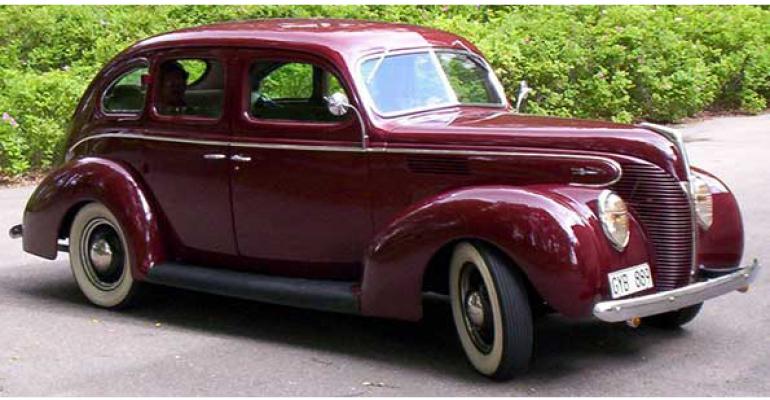75 Years Ago (June 1939): UAW Factions Battle; May Output Up; Turn Signals, Electric Wipers Seen
The two factions within the UAW, one backed by the CIO, the other by the AFL, continue to spar over representing workers at various auto and supplier plants.
The nearly month-old Briggs Mfg. strike by the UAW-CIO seeks to establish a “union shop” with all workers required to contribute to the union, a move being strongly resisted by Briggs with automaker backing. Because of this, “a lengthy deadlock seems in sight unless the union abandons its stance in this regard,” says Ward’s Automotive Reports.
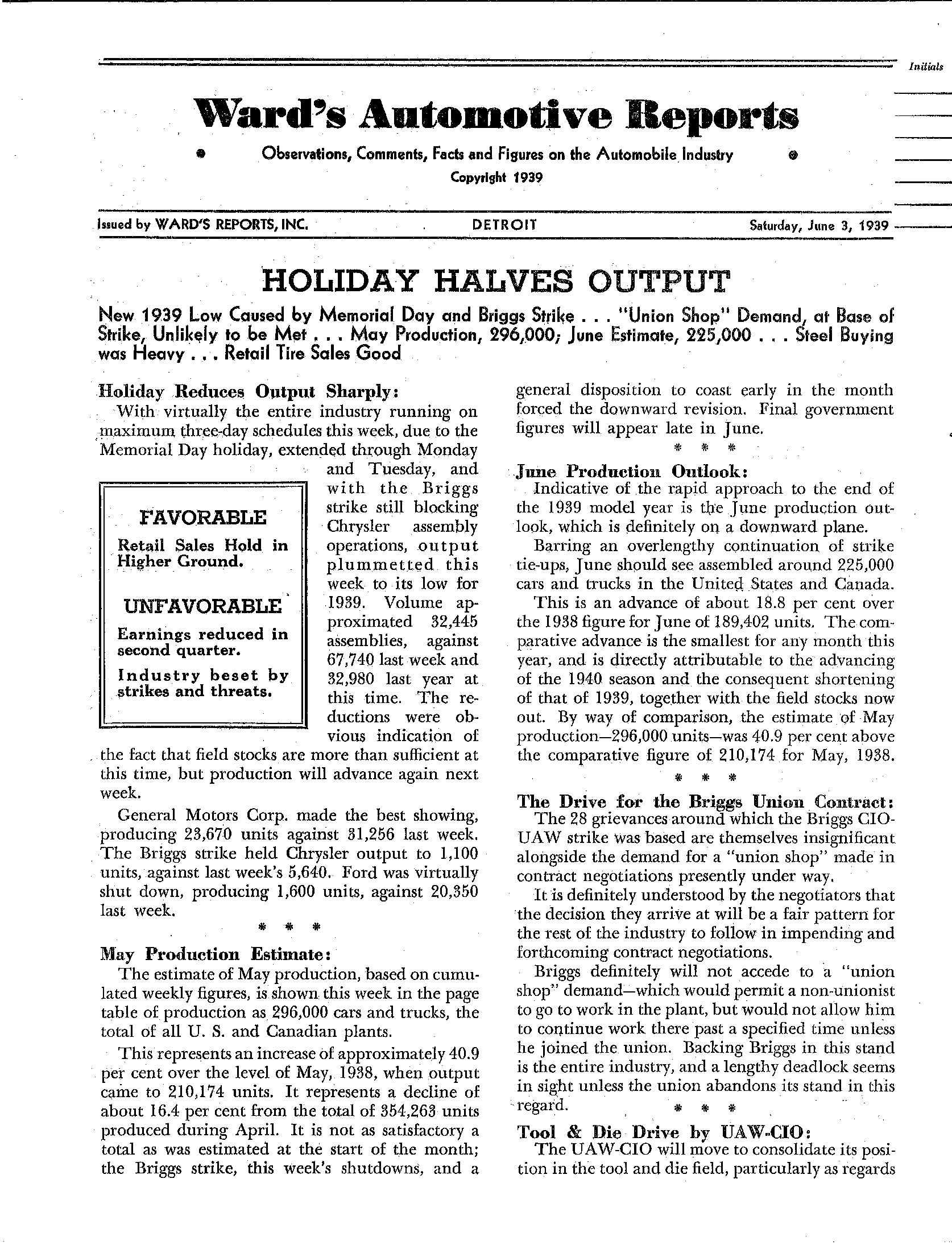
Meanwhile, the UAW-AFL launches a mid-month strike at General Motors’ Flint operations, hoping to consolidate its hold there, leading WAR to comment, “Such disturbances are forerunners of more widespread and continuous jurisdictional troubles which, unfortunately, give evidence on continuing until the spheres of influence of the two unions are clearly defined.”
Hoping to diffuse the situation, the National Labor Relations Board amends its procedures to allow automakers as well as unions to petition for a representation election. Previously, only unions could seek a vote.
Despite the Briggs strike and other labor woes, May vehicle production in the U.S. and Canada is estimated by Wards at 296,000 units, a 40.9% gain on like-1938’s recession-hit 210,174 completions. Still, that is 10.3% short of the 330,000 assemblies forecast at the start of the month and 16.4% below April’s 354,263 vehicles. Industry-leader Chevrolet in May trails rival Ford (including Mercury) with 68,000 units vs. 73,500, but leads by 13,150 for the year — 408,000 vehicles vs. 394,850.
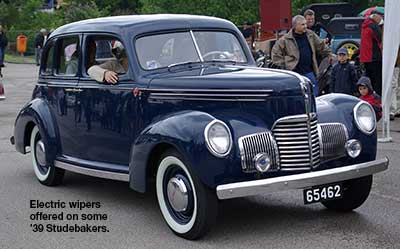 In other news, reports indicate Buick is preparing to install rear directional signals on its ’40 models, possibly as standard equipment. Other makes, including Ford and Chrysler, also are rumored to be considering making similar equipment optional.
In other news, reports indicate Buick is preparing to install rear directional signals on its ’40 models, possibly as standard equipment. Other makes, including Ford and Chrysler, also are rumored to be considering making similar equipment optional.
At the same time, Electric Auto-Lite reveals it has an electric windshield wiper system being evaluated by the engineering departments at several automakers. Chrysler, Dodge, De Soto and Studebaker already offered electric wipers on certain ’39 models, while Plymouth may offer them as an option in ’40.
Despite the electric wiper’s inherent advantages over less-costly vacuum-operated wipers that, for instance, tend to slow and/or stop completely under hard acceleration due to lack of manifold vacuum, they do not become the industry standard until the 1960s.
70 Years Ago (June 1944): Civilian Output Up; 4.0 Million Scrapped; FI, Auto Trans, Rear Engines Seen
Despite severe labor shortages, especially in foundry and casting operations, truck output in the first four months of 1944 is up 9%, according to WAR data.
Total output of 228,347 units in January-April vs. 208,679 in like-1943, includes 18,039 vehicles for civilian sale, up substantially from just 863 units a year earlier. Of this year’s civilian-use total, 13,330 units are medium-duty models in the 9,000-16,000-lb. gross vehicle weight category and 4,709 units have GVWs over 16,000 lbs.
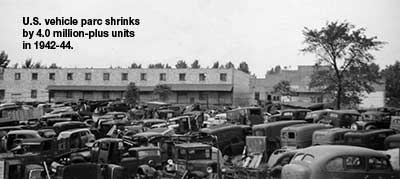 All of the units built in January-April 1943 were over 16,000 lbs. Military-truck output so far in 1944 totals 210,308 vs. 207,816 a year earlier. Light trucks, under 9,000-lbs. GVW, account for 39.6% of this year’s “military” tally compared with 47.0% year-ago, “mediums” 18.9% vs. 15.1% and “heavies” 41.5% as against 37.9%.
All of the units built in January-April 1943 were over 16,000 lbs. Military-truck output so far in 1944 totals 210,308 vs. 207,816 a year earlier. Light trucks, under 9,000-lbs. GVW, account for 39.6% of this year’s “military” tally compared with 47.0% year-ago, “mediums” 18.9% vs. 15.1% and “heavies” 41.5% as against 37.9%.
According to data from the Public Roads Admin., U.S. motor-vehicle registrations totaled 30,499,608 at the close of 1943, down 6.4% from 32,582,244 units in 1942. Compared with the 34,461,018 vehicles tallied in 1941, more than 4.0 million cars and trucks have been scrapped and not replaced due to the virtual ban on production of cars and trucks for the civilian market that began early in 1942.
 Among the highlights of an early June SAE conference in Detroit, much interest was shown in a presentation on post-war use of fuel injection in cars and trucks.
Among the highlights of an early June SAE conference in Detroit, much interest was shown in a presentation on post-war use of fuel injection in cars and trucks.
Smoother engine performance, more power and greater fuel flexibility appears to favor FI over carburetors. “Excessive first cost and relatively high maintenance expense of present injectors are seen as limiting factors,” WAR says.
Also of great interest to attendees were the hydraulic (automatic) transmission, forecast to become available in virtually every car, and the rear-mounted engine. Proponents of rear engine placement declared the “pusher-type” car “will suddenly emerge to make present models as obsolete as front-engine buses.”
60 Years Ago (June 1954): Chrysler Proving Grounds Open; Continental Tooling; Factory Deliveries Rise
Chrysler invites 600 reporters to the opening of its new Chelsea, MI, proving grounds on June 16, 1954. Speed and endurance records “fell by the bushelful” as part of the extravaganza that included: “(1) daredevil stunt driving; (2) demonstrations of the high-speed maneuverability of Dodge truck-trailer combinations; (3) world speed records by the nation’s leading Indianapolis 500 race drivers; (4) parades of ‘idea’ cars; (5) a demonstration of a Chrysler turbine-powered car and (6) speed records set by a Dodge Firearrow 2-passenger concept car,” according to WAR.
“A sight that seemed to make a profound impression on guests was a series of cars with a tire exploding as they passed the grandstand, demonstrating the ability of drivers to easily maintain control of models equipped with Chrysler’s wider wheels and optional power steering.”
In one of its periodic “Bulletins,” WAR reveals that Ford plans to build initial bodies for its upcoming Lincoln Continental hardtop from Kirksite dies made from lead and titanium. The “soft” dies are designed to accommodate the relatively small first-year run of 2,500 units. Rumors abound that “the youngest of the three Ford brothers will manage Continental and Lincoln divisions.”
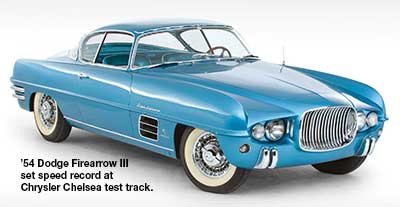 Some automakers are beefing up their factory retail driveaway programs by expanding facilities to accommodate increased interest in the program.
Some automakers are beefing up their factory retail driveaway programs by expanding facilities to accommodate increased interest in the program.
Brands pushing the concept believe letting customers purchase their vehicle at the local dealer and pick it up at the factory (thereby saving the destination charge) is “a golden opportunity to build good will which may bring the buyer back for a new model next year.”
Lincoln-Mercury Div. is among those actively promoting the program, having delivered 1,728 cars from its Wayne, MI, plant through May of this year.
At Cadillac, some 50 cars daily are delivered through the program, up from 25-30 in 1953. Pontiac is gearing up to accommodate 55-60 such deliveries a day this year vs. 45-50 last year, by expanding its delivery area.
While Ford Div. and Chrysler are not hyping factory delivery, Kaiser-Willys is studying whether a stepped-up program will increase overall sales.
50 Years Ago (June 1964): Chrysler's Rootes Stake; CA Rule Hit; Excise Tax Slammed; Gas Prices Surveyed
Hoping to increase its European “take,” Chrysler reveals, June 6, it is buying a 30% stake in the British Rootes Group for $34.5 million.
Existing Chrysler U.K. operations will be folded into Rootes, once the agreement is completed. But despite Chrysler’s stake, Rootes confirms it still will use Ford’s 260-cid (4.3L) V-8 to power its Sunbeam Tiger sports car, a high-performance variant of the 2-passenger, 4-cyl. Alpine.
Due to hit U.S. dealers in July, the Tiger is in concept similar to the Ford-powered AC Ace-derived Shelby Cobra. But, the Tiger is fitted with more upscale accoutrements at an East Coast port-of-entry price of $3,600.
Despite the eventual Chrysler takeover of Rootes, the Tiger will retain its Ford V-8, later a 289-cid (4.7L) variant, reportedly because Chrysler’s smallest V-8, a 273-cid (4.5L) job is too large to fit. Production ends after ’67 due to the cost of re-engineering the basic car to meet new ’68 safety and emissions standards.
 Automakers are expected to raise strong objections to four new smog-control devices approved this month by California’s Motor Vehicle Pollution Control Board for mandatory installation on ’66 models sold in the state.
Automakers are expected to raise strong objections to four new smog-control devices approved this month by California’s Motor Vehicle Pollution Control Board for mandatory installation on ’66 models sold in the state.
Three of the devices are of the “catalyst” type that chemically oxidizes exhaust fumes, while the fourth is an afterburner designed to reduce hydrocarbon emissions. Industry objections center on the $50-$120 cost of the systems.
Automakers prefer a simpler system being developed by Chrysler and currently under evaluation by the MVPCB. The “Cleaner Air Package System” utilizes a spark advance mechanism to burn excess pollutants as the engine decelerates or idles. Cost of CAPS is said to be less than $10 per car.
In a rare front-page editorial, WAR’s publisher calls for ending the federal excise tax on cars.
“The punitive 10% auto excise tax is due to expire June 30. As it has done since the Korean War, it will be renewed for another year unless Congress is stirred to act.
Ending the tax will lead new-car buyers to trade in their old cars sooner, make available more newer used cars and scrap junkers faster.
Write or wire your Senators to end now this tax that costs the new car purchaser anywhere from $200 to $700.”
A 20-city survey indicates the cheapest gasoline, excluding state sales taxes, currently is sold in Minneapolis for an average $0.25 per gallon for regular and $0.29 for premium.
The highest prices were recorded in New York City, where regular is priced at $0.35 and premium at $0.38. In Detroit, $0.27 is the going price for regular vs. $0.32 for premium.
26 Years Ago (June 1988): DOHC Use Up; Suzuki Blasts Report; Chrysler's GM Bid; 'Dumping' Charged
The use of double overhead camshaft engines is on the rise in model year ’88. A Ward’s survey shows usage of DOHC engines (all 4-cyl.) has risen dramatically to 89,652 units in the model year through Apr. 30, from just 27,481 in the entire ’87 run.
GM’s all-new Quad 4, the only DOHC engine built in the U.S., accounts for 93.6% of the DOHC powerplants used in ’88. Pontiac reported the highest volume, installing the Quad 4 in 38,983 Grand Am models.
 Olds’ Calais was a close second with 37,229 cars while Buick’s less performance-oriented Skylark installed only 7,722 units.
Olds’ Calais was a close second with 37,229 cars while Buick’s less performance-oriented Skylark installed only 7,722 units.
The NUMMI-built Chevy Nova and Toyota Corolla FX16 featured 3,875 Toyota DOHC engines built in Japan compared with 21,100 FX 16s in the entire ’87 run.
Likewise, Volkswagen installed 1,843 German-sourced DOHC engines in its Westmoreland, PA-built GTi in ’88 vs. 6,381 the prior year.
Suzuki of America Automotive blasts the demand from a leading consumer magazine (Consumer Reports) seeking the repurchase of all 150,000-plus Samurai small SUVs sold in the U.S., calling the vehicle “unsafe” due to a propensity to easily roll over during testing. Suzuki claims its “real world” data show few rollovers and says it may sue for a retraction and damages.
 Audi says it will attempt to settle a class action lawsuit over unintended acceleration in its 5000-Series models by offering owners credits of $300 to $2,000 toward the purchase of a new Audi between Sept. 1, 1988, and June 30, 1991.
Audi says it will attempt to settle a class action lawsuit over unintended acceleration in its 5000-Series models by offering owners credits of $300 to $2,000 toward the purchase of a new Audi between Sept. 1, 1988, and June 30, 1991.
The much-publicized flap over unintended acceleration in the Audi 5000 is, in the end, judged to be driver error, leading to a federal requirement that drivers of automatic transmission-equipped cars be prevented from shifting out of “park” unless the brake pedal is fully depressed.
GM tells WAR it was not aware of Chrysler’s spring-1987 discussions of a possible takeover of the company, reportedly initiated by a megadealer holding a number of GM, Chrysler and Dodge franchises. In his book Talking Straight, Chrysler’s Chairman says the idea was shot down, but later revived by the Chairman of Allied-Signal, who proposed a joint-takeover bid.
 The idea is said to have been floated at the same time GM, fearing it could be a takeover target, was formulating plans to repurchase 20% of its stock by 1990.
The idea is said to have been floated at the same time GM, fearing it could be a takeover target, was formulating plans to repurchase 20% of its stock by 1990.
Representatives of Chrysler, Ford, GM and the Motor Vehicle Manufacturers Assn. meet in Washington with the Secretary of Commerce to urge the federal government press Japan to stop its manufacturers from selling compact pickups in the U.S. below cost.
The MVMA says it has documents showing the extent of “dumping” and the harm it is doing to U.S. producers and workers.

